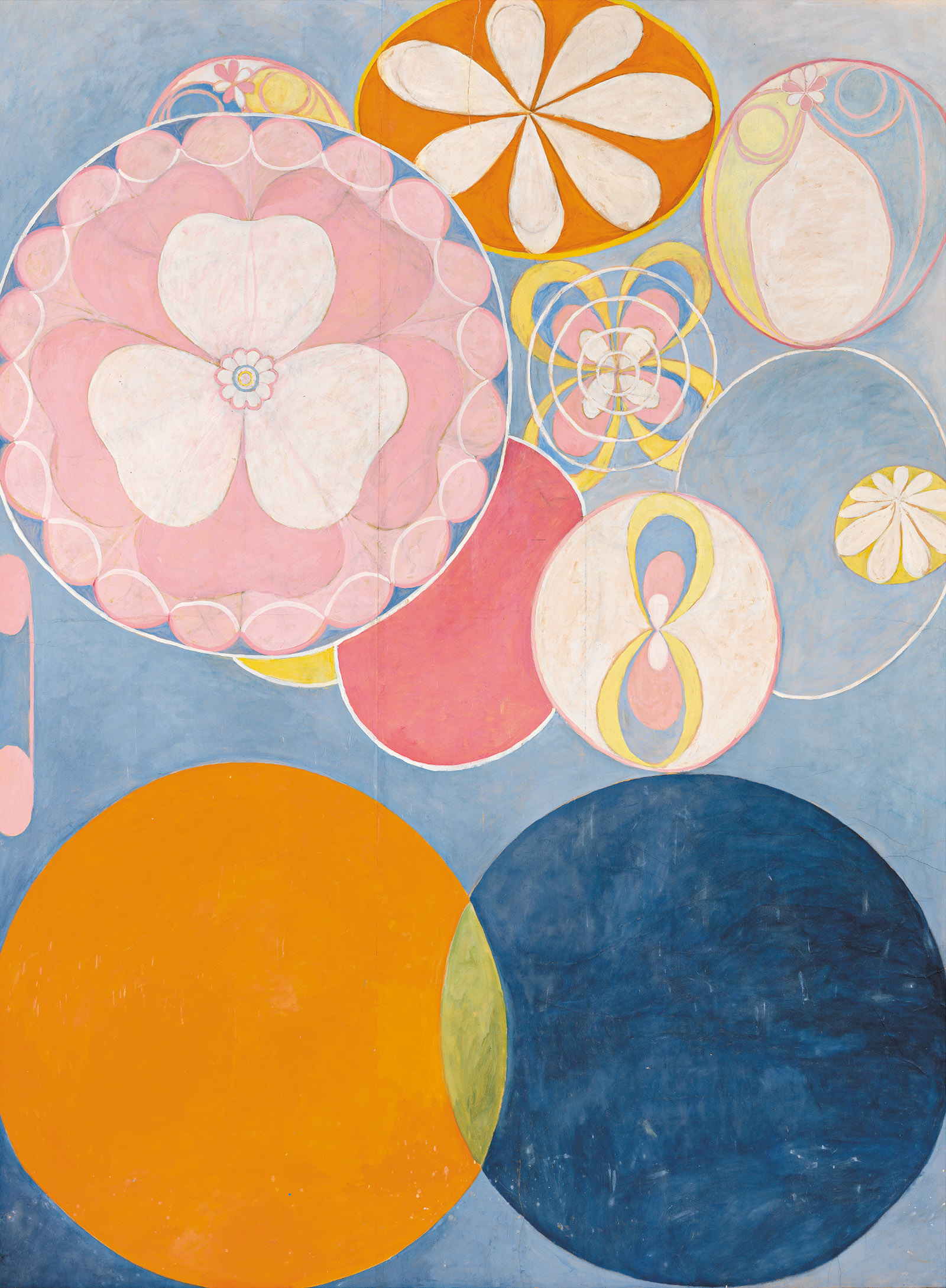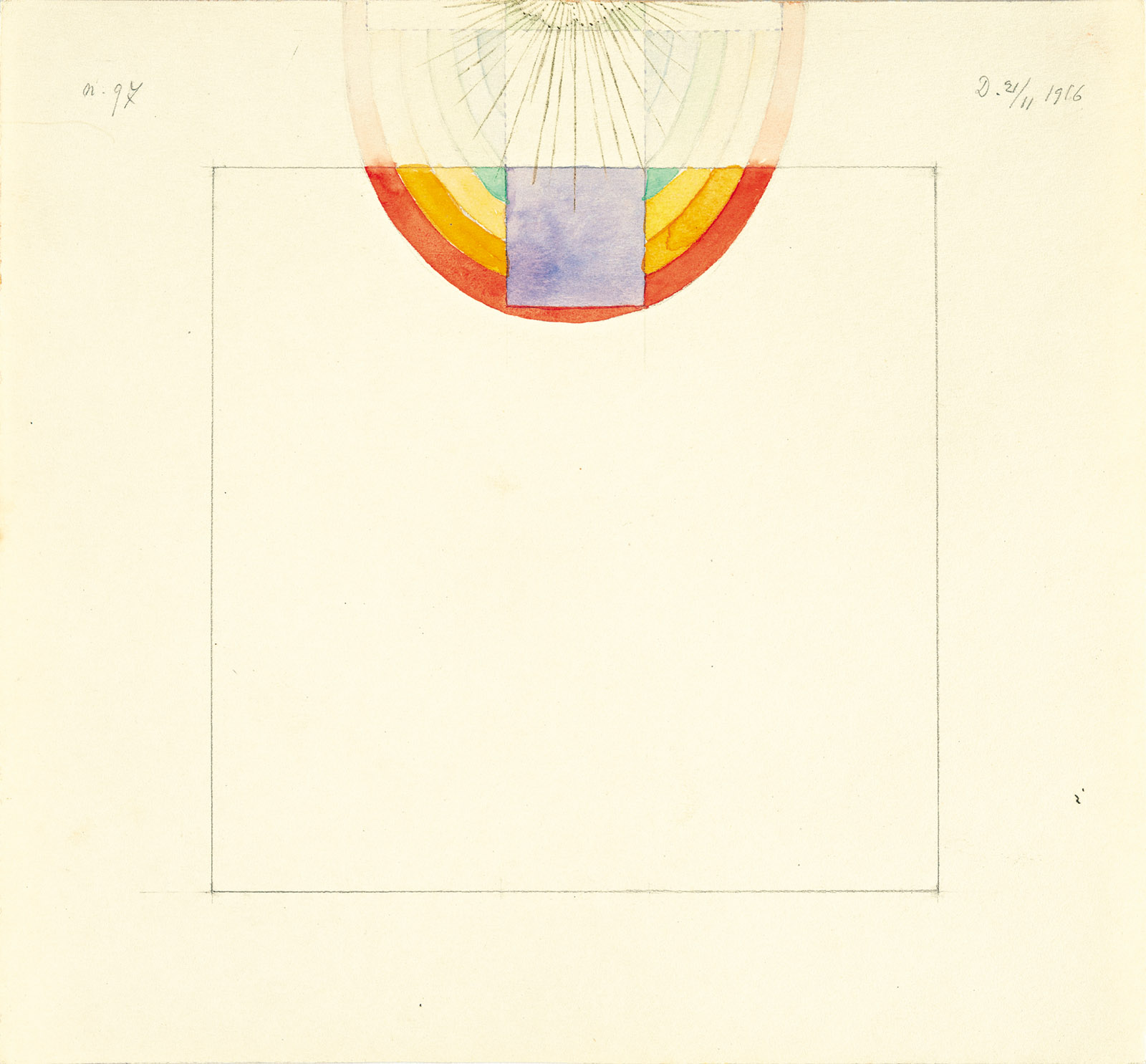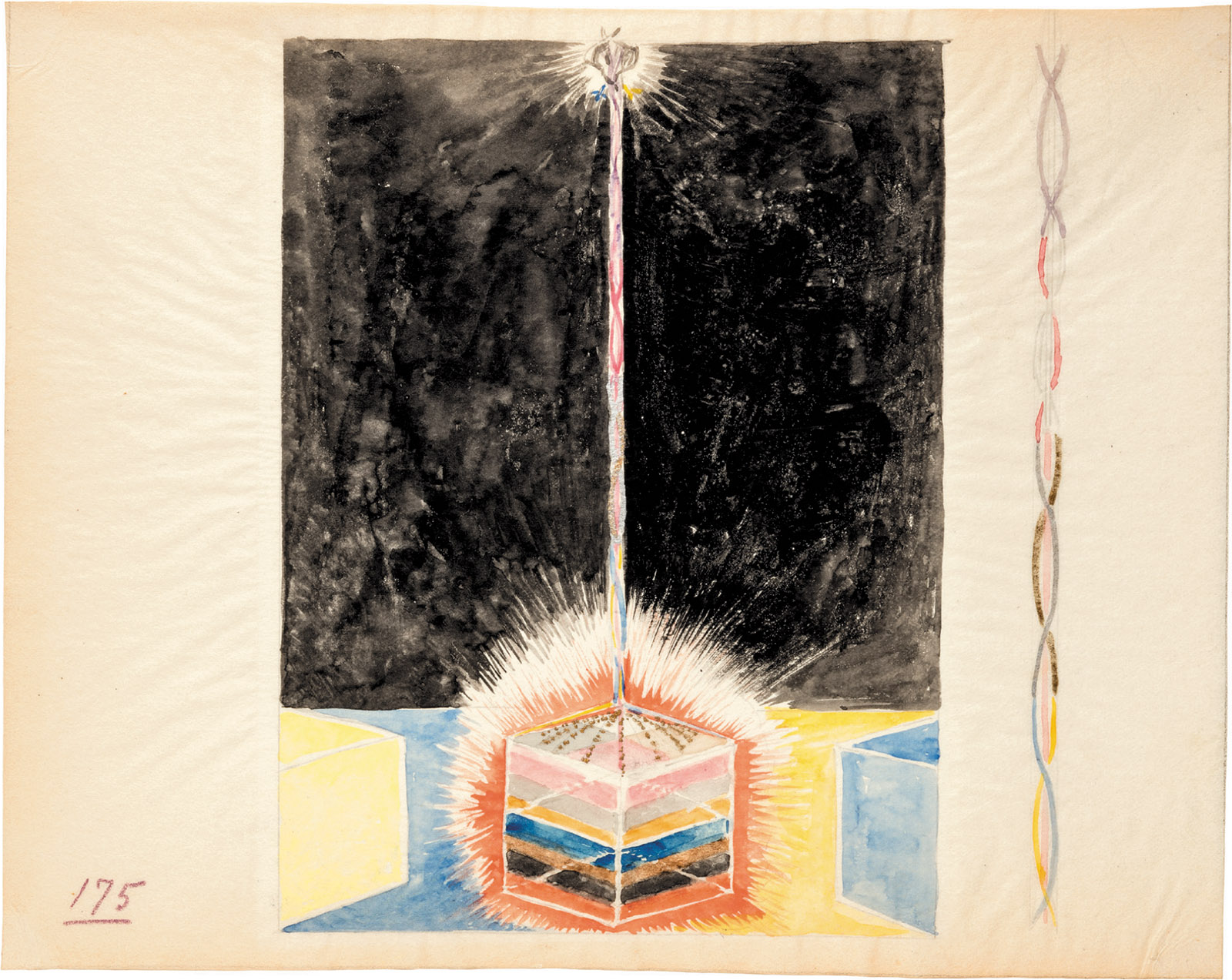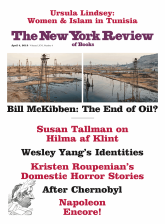Born in 1862 to a prominent Swedish family (her great-grandfather had been ennobled for services as a naval officer), Hilma af Klint was a skilled painter of portraits and landscapes who in the first decades of the twentieth century began making hundreds of strange pictures articulating the fluid relations between spirit and matter. Many have no basis in the visible world, and their early dates—in some cases years before such benchmark abstract paintings as Wassily Kandinsky’s Composition VII (1913) or Kazimir Malevich’s Black Square (1915)—have led to excited claims for af Klint as the unknown woman who pipped all the famous men to the post. This is the seductive pitch behind the Guggenheim’s much-lauded exhibition “Hilma af Klint: Paintings for the Future,” the first comprehensive American overview of the artist now hailed, some seven decades after her death, as the female progenitor of modernist abstraction. Even if this were true—and it really isn’t—it would be the least material or interesting thing about this ecstatic and perplexing body of work.
Af Klint was one of many artists (including Kandinsky and Malevich) drawn to the esoteric philosophies that flourished in the late nineteenth and early twentieth centuries—Spiritualism, Theosophy, Anthroposophy, and the like. But af Klint’s engagement went deeper than most, and she was tenacious in her pursuit of personal spiritual contact. Her greatest work, the series of 193 Paintings for the Temple, was made by channeling spirit-masters who she claimed moved her hand and planted images in her mind. She spent the rest of her life mulling over what they gave her.
When af Klint died in 1944, she left more than 1,200 paintings, 134 notebooks and sketchbooks, and more than 26,000 manuscript pages to her nephew, a vice-admiral in the Swedish navy. She also gave instructions that her work not be shown for twenty years after her death. She was lucky in her relations: the family not only adhered to the moratorium, they established a foundation to ensure that the paintings and documentation stayed together. Beginning with her inclusion in the 1986–1987 Los Angeles County Museum of Art show “The Spiritual in Art: Abstract Painting, 1890–1985,” awareness of af Klint began to percolate, and recent years have brought a burst of new scholarship; an ambitious traveling survey organized by Stockholm’s Moderna Museet as well as, most recently, concurrent exhibitions in New York and Munich; and the English-language publication of several of her notebooks. It would appear that af Klint’s moment has come at last: the work is now being seen by thousands, though whether they are ready to receive its message is another question.
Apart from her nonconforming beliefs, af Klint led a fairly staid life. She trained at the Royal Academy of Fine Arts in Stockholm, graduating with honors in 1887, and was awarded a studio in the city’s art district. Within the compass of opportunities available to women artists, she was successful—participating in exhibitions, traveling, taking commissions, illustrating a book on equine surgery. The handful of her professional works included at the Guggenheim reveal an attentive eye and confident hand. If her landscape suggests a toe dipped in the water of the Barbizon school painterly style, her tender, precise nature studies and portraits (including a fetchingly alert dog) suggest an understanding of images as more than emotional prods—a sense of their status as carriers of information.
She became interested in spirituality as a teenager, and read widely on Christian mysticism, Eastern religions, Judaism, and science, particularly those discoveries that, like electromagnetism, revealed invisible energies within inert matter. The loss of a beloved sister when she was eighteen may have exacerbated her need to reach beyond the material world, but she was already inclined toward grand theories of everything that encompassed both the “how” of physics and the “why” of religion. In her mid-thirties af Klint began holding regular séances with four other women (they called themselves de Fem, or “the Five”). Educated Christian spiritualists, they began their sittings with Bible readings and kept careful records of their protocols and results—who acted as medium, which spirits were contacted, and what messages were received. Like other such groups, the Five produced “automatic” drawings that recorded the movement of a pencil held by the medium but directed by spirits, who seem to have been fond of amoeba-like blobs, skittering lines, spirals, and rhythmically repeated geometries.
After eight years of contact, the spirit-masters announced that a temple should be built and filled with paintings. Following another two years of discussions, the Tibetan spirit guide “Amaliel” asked af Klint to take on this task. “I immediately said Yes,” she wrote. “The expectation was that I would dedicate a year to this task. In the end it became the greatest work of my life.” She began The Paintings for the Temple in late 1906, at the age of forty-four. In little over a year she had produced 111 pictures, all of them, she explained, “painted directly through me, without any preliminary drawings and with great force. I had no idea what the paintings were supposed to depict.”
Advertisement
Whatever one thinks about Amaliel, two things are clear: The Paintings for the Temple look like nothing af Klint had painted before, and like nothing in contemporary European art. Wildly divergent in style and content, they range from spare calligraphic loops to cartoonish explosions and enigmatic tables of gestural marks. Letters and words run in every direction. There are lots of snails. In 1908 af Klint arranged to show the paintings to Rudolf Steiner, the founder of Anthroposophy and the thinker she most admired. But Steiner disapproved of mediumship, believing that spiritual truths were found by looking inward, and the meeting was not a success. Despite this setback, af Klint returned to The Paintings for the Temple, but their character changed: instead of moving her hand directly, the spirits now presented her with a mental image to execute, and the paintings took on a crisper, more formal demeanor.
Af Klint ceased channeling once The Paintings for the Temple were completed in 1915, though she continued to study the spiritual structures she believed were hidden behind the visible surfaces of the material world, and to invent pictorial devices to explain them. For several years she painted quietly sublime watercolor series on mystical subjects, such as Parsifal (1916) and The Atom (1917)—named after her term for the intersection of physical and “etheric” planes. Like The Paintings for the Temple, these also feel weirdly out of time. With their minimal geometries and serial alteration of color or shape, they might have been made in the 1970s rather than the 1910s. One lovely pair on view at the Guggenheim show a vacant square, outlined in pencil, at the top of which a small slice of rainbow floats up and into the margin, where it half-disappears (see illustration below). A more concise summary of the idea that there is “something beyond” is hard to imagine.
The gravitational center of “Paintings for the Future,” however, are The Paintings for the Temple. The most spectacular of these, The Ten Largest—so called by af Klint herself—are hung together in a room at the bottom of the museum’s ramp to form the exhibition’s jubilant kick-off. Nearly eleven feet tall, they fill the eye with deftly juggled color and form in a manner entirely unlike the busy, fractured compositions with which Kandinsky edged his way into abstraction. Af Klint’s schematic flowers and loop-the-loop letters are big and flat and bold, and they bump up against a bevy of odd motifs resembling embroidery patterns, barn hexes, corkscrew diatoms, and Parcheesi boards. It is tempting to credit af Klint with a protofeminist synthesis of folk art, scientific illustration, and spirography, but her explanation was simpler: “Amaliel draws a sketch, which H then paints.”
The euphoric energy of The Ten Largest is lost somewhat in reproduction, not only because of the reduction in size, but also because the slapdash nature of their materials and execution doesn’t come across. Fast and provisional, they were painted in tempera on paper, like a school project. Footprints on their surfaces suggest she worked on the floor, and though the paper is now adhered to canvas, you can see crumples and seams—details that undermine any incipient grandiosity. One might assume that, like the large-scale cartoons of Leonardo or Raphael, these were meant as instructions for tapestries or murals, but while af Klint spent decades documenting and interpreting The Paintings for the Temple, she never remade them in a more polished form. She must have seen them as succeeding at what they were supposed to do.
And what was that exactly? Kandinsky thought that spiritual art caused “a responsive vibration” in the viewer’s soul, and watching visitors take in The Ten Largest, it is easy to detect something like responsive vibrations in the relaxed smiles, slowed feet, and raised phones. But af Klint’s (or Amaliel’s) paintings were meant to do more than vibrate; they were supposed to convey knowledge. The Ten Largest, for example, illuminate the course of human life—from the ornamental gametes of Childhood, through the boisterous spirals of Youth, and lettered life of Adulthood, to the pale symmetrical order of Old Age.
Few of the other paintings reach this degree of perfection, though many are commandingly beautiful. In some, however, the balance between “vibration” and didacticism tilts away from visual pleasure. Arranged in ordered series and subgroupings, these paintings ask to be read, not just viewed, and the reading is difficult. They are peppered with symbols and emblems—some are common knowledge (zodiac signs, crucifixes) and some are intuitive (a spiral indicates both cyclical return and progress to someplace new; symmetrical divisions invoke the meeting of opposites), but to decipher the significance of the words and letters we need a crib sheet, and even then there is the difficulty of figuring out what it all means in combination. The process can feel less like viewing art and more like struggling to get the gist of a newspaper article in a language you don’t speak.
Advertisement
It prompts the question: Is this really “abstract art”? Nothing stands alone; everything is a shorthand for something else. The Guggenheim has some skin in this game, of course, having been established as a museum of “non-objective” art by people who saw abstraction as the great invention of twentieth-century culture: “Never before in the history of the world,” wrote its founding director, Hilla Rebay, “has there been a greater step forward from the materialistic to the spiritual than from objectivity to non-objectivity in painting.” The building was to be a “temple of non-objectivity and devotion.” There is, in fact, a serendipitous play of form between the building and some of af Klint’s paintings: the repeated spirals most obviously, as well as the large divided circles that increasingly occupy the canvases we see as we climb closer to Frank Lloyd Wright’s enormous oculus.
But the claim for af Klint as an inventor of abstract art runs into two serious problems. The first is that it doesn’t seem to match how she thought the work should function. The second is that abstraction was “invented” in the same sense that the Western Hemisphere was “discovered.” Millions of people knew about both for millennia, just not the people who counted. It is a myopia that art historians have helped sustain through their habitual “canvas or it didn’t happen” bias, but once you look beyond easel painting, it becomes clear that af Klint’s seemingly unprecedented visual language had been circulating for centuries in the diagrams, illustrations, and serial formats of books and prints. If you turn to crafts, af Klint’s flattened flowers, curlicues, and nested patterns also start to look familiar.
To its credit, the Guggenheim catalog supplements its informative biographical essays with texts examining connections to Swedish folk art, diagramming, and some discussion of print culture more broadly. The exhibition hanging, however, tacitly promotes the perception of af Klint’s paintings as self-standing aesthetic objects. And this is the crux of the Hilma af Klint dilemma: To what degree does celebrating these things as works of art, and celebrating af Klint as their creator, invalidate everything she was hoping to achieve?
This question is front and center in the exhibition “World Receivers” at the Lenbachhaus in Munich, which placed af Klint in the company of the Victorian Spiritualist Georgiana Houghton (1814–1884) and the Swiss clairvoyant Emma Kunz (1892–1963), who also made art by channeling external forces. Foreshadowing the language af Klint would use half a century later, Houghton wrote, “My hand has been entirely guided by Spirits, no idea being formed in my own mind as to what was going to be produced.” Unlike af Klint or Anna Mary Howitt (1824–1884), Houghton’s precursor in spirit drawing, Houghton encountered spirits who largely abjured readymade symbols. It was a wise choice—a weirdly coiffed, big-eyed Christ in one of her drawings suggests that figuration was not these spirits’ strong suit.
Instead, they let loose for Houghton resplendent currents of line, divorced from any mimetic purpose beyond the kinesthetic release of energy (imagine a cross between Albrecht Dürer, Surrealist drawings, and meteorological maps). Produced in the 1860s and 1870s, these astonishing drawings should put to rest any notion of af Klint (never mind Kandinsky or Malevich) as the “originator” of pure abstraction in Western art. (Houghton has received far less exposure than af Klint; exhibitions at Monash University in Melbourne in 2015 and the Courtauld Institute in London the following year were the first to bring her to the attention of non-Spiritualist circles. Most of her drawings remain in Spiritualist collections.)
Emma Kunz, coming a generation after af Klint, relied not on séances but on a pendulum she used to detect “force streams” as the basis for her intricate geometric drawings. An acclaimed spiritual healer, Kunz was self-taught as an artist and employed her images as both mandala-like foci for meditation and I Ching–like emblems for divination. Made on graph paper with colored pencils, ruler, and compass, Kunz’s tessellations, webs, and pseudo-curves of massed straight lines manage to echo Islamic tile work, while predicting string art and early computer graphics.
Though all three women referred to the pictures they made as “art,” they recognized that the images functioned differently from the things that hang in galleries and museums. Af Klint made a clear division between her art career and her mystical endeavors. Though she called The Paintings for the Temple the greatest work of her life, only once did she exhibit any of them—and then it was not in an art venue but as part of the World Conference of Spiritual Science and Its Practical Applications in London in 1928. Even Houghton, who once rented a London gallery to promote her work and evangelize for Spiritualism, acknowledged that her images “could not be criticized according to any of the known and accepted canons of art.”
Today the largest impediment to satisfying those known and accepted canons is not the works’ visual appearance; it is the artists’ deflection of authorship. The Lenbachhaus catalog opens with a sketch of Kandinsky at a séance, circa 1909. But rather than suggest an equivalence between the great man and af Klint, Houghton, and Kunz, the juxtaposition highlights a critical distinction: though Kandinsky was deeply concerned with the spiritual, he never denied his own role in directing his work. Af Klint, Houghton, and Kunz all did so explicitly; their statements, as well as aspects of their work, wrong-foot us when it comes to thinking about their images as art. Roland Barthes’s “death of the author” notwithstanding, at no time in history have we been more concerned with assigning authorship, and nowhere more than in the art world. It’s why reattributions cause such a fuss—they don’t just change a work’s value, they alter its meaning.
In the Lenbachhaus catalog, Karin Althaus does a deft job of explaining how Houghton, Kunz, and af Klint viewed their work, and acknowledges the all-important fact that for the artists these were not just images but indexical evidence of another realm of existence. Strip away their supernatural origin and the works become meaningless in the artists’ own terms, whatever they might do for us aesthetically.
The reclamation of Hilma af Klint as a major twentieth-century artist, however, has entailed discreetly discounting her claims of supernatural intervention in order to reposition her art as the product of more conventional processes and pressures: biography, psychology, stylistic comparison, social milieu. Her turn to Spiritualism, for example, is explained away as a reaction to the hurdles placed in the way of female artists. This neatly transforms an alien irrationality into a rational—potentially heroic—political strategy. But it ignores the reality that while women were indeed prominent in spiritual reform movements, it was a double-edged sword: the power of mediumship is predicated on willed powerlessness, an emptying out of the self to allow other powers to speak through you.
There is, it seems, something condescending about the notion that had af Klint lived in more enlightened times (female artists of a certain age can stifle a laugh here), she wouldn’t have needed Spiritualism. Her resolute pursuit of mystical knowledge over the course of six and a half decades suggests that, for her, this was not some second-best scenario.
The rationalization of af Klint’s psychology goes hand in hand with a curiously unquestioned assumption that the ultimate goal of pictures is to be hung in a museum. Again there are good reasons to doubt that this was what af Klint was after. Hilla Rebay and Amaliel may both have used the word “temple” to describe their projected houses for painting, but they weren’t really talking about the same thing.
In this sense, af Klint offers an object lesson in how ill-equipped we are to deal with art that defies a psychological or sociological reading. On those grounds she remains a cipher, seemingly by her own design. Historians have found it difficult to reconstruct her biography because she left behind so few letters or photographs. “‘I’ is not a word often found in her writings,” Julia Voss notes in the “Paintings for the Future” catalog. And yet few artists have written and documented so much: those hundred-plus notebooks and sketchbooks, the thousands of manuscript pages. (Very few of these have been translated into English.)
The remarkable, welcome thing about Christine Burgin’s Hilma af Klint: Notes and Methods is that it lets af Klint speak for herself, if not about herself, through the glossaries in which she offered explanations of the words and abbreviations that fill her drawings and paintings and through high-resolution reproductions of the pages of her notebooks. These include early nature sketches and automatic drawings from séances, as well as later watercolors and an extended study of the energy “signatures” of particular plant species. The center is held by The Paintings for the Temple, which af Klint cataloged sometime after their completion in ten coordinated blue books, rendering each in a watercolor, in most cases paired with a black-and-white photograph, encouraging a game of spot-the-difference.
In book form, unified in size and material, and made intimate and flippable, the paintings reveal themselves differently than they do when hung on a wall and interrupted by architecture: they take on an overall rhythm, and the shifts between abstraction and figuration become fluid rather than clunky. The blue books were compiled years after the paintings were made, so it is interesting to note how closely af Klint adhered to the originals, copying rather than correcting Amaliel’s awkward figure drawing, for example, although her naturalistic drawings prove her to have been a virtuosic draftsperson.
This faithfulness to the source makes sense if we understand that in the blue books, as much as in her studies of lichens, she is examining something outside herself, observing and recording it as precisely as possible, trying to figure it out. In the notebooks, her naturalism and her metaphysical diagrams are visibly related; both invoke the tremulous excitement of watching and identifying. Perhaps the real “temple” for af Klint is not the big snail shell on Fifth Avenue but the archive, with Notes and Methods as its picture bible. Here the main takeaway is not abstraction but complexity; the multivalent truths of series and sets, rather than the monocular truth of painting.
Each of these publications reveals something essential about af Klint—the Guggenheim presents the clearest overview of her life and how she intersected the art world of her time; the Lenbachhaus does groundbreaking work in placing her within the setting of Spiritualist practice; and Notes and Methods offers a window into the consistency of her thought. And yet the essence of that thought remains difficult to embrace. The last section of Notes and Methods is an English translation of af Klint’s glossary: “AmaH = prison,” “bn = muteness,” “mus = the zeal for faith among the mediumistically gifted; we call it spiritual recklessness.” Opposite the first page of abbreviations she wrote: “The following three concepts are taken as a starting point: 00 0 00.” In its promise of clarity and its functional opacity, it might be a piece of witty conceptual art—a mythical collaboration between, say, John Baldessari and Ed Ruscha circa 1973. But like the other contemporary comparisons that make af Klint feel somehow relatable, this scuppers on the rocks of her belief. For her, the promise wasn’t a joke, and the glossary was not nonsensical. Coming at the end of this insightful volume, the glossary acts as a reminder of the gulf that separates the believer from the skeptic.
It is unrealistic to think that anyone outside a handful of scholars is going to master af Klint’s hermetic symbolism; fewer still will be converted. While the celebration of Hilma af Klint at the Guggenheim is a triumph, it is bittersweet. The Paintings for the Temple may now be hailed as a work of genius, but where people were supposed to understand truth, most merely see beauty. Where they were supposed to understand “spirit,” they recognize an artist. Perhaps, though, in responding to the joy and inventive power of her work, we can at least acknowledge its origins in a kind of faith that most of us lack, while recognizing an impulse many of us share—the desire to pin down a meaning greater than the self.
This Issue
April 4, 2019
A Future Without Fossil Fuels?
The Chernobyl Syndrome






